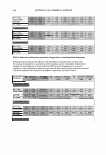ADHESION FAILURE IN HAIR 355 • The delta layer stains with PTA. This is either a reaction of hydroxyl groups of a polysaccharide or of a primary amine function. Swift (2) has explained that this reaction is blocked with FDNB therefore, it is more likely a reaction involving primary amine groups, consistent with a globular protein. • The delta layer reacts with periodic acid/silver methenamine (2), a method for poly saccharides however, since cystine interferes with this reaction, it is still consistent with a globular protein in the delta layer. We believe that these models, with their proposed interconnecting bonds, help to explain where failure can occur and how it occurs, and we will use these models in that manner in the following discussion. SOME GENERAL RULES OF ADHESION FAIL URE Strain (the amount of deformation) more than stress determines how failure occurs in hair fibers. Stress-strain curves in the wet versus the dry state show much greater strain (deformation) in the wet state prior to entering into each successive region of the curve or even breakage (11). Faster rates of extension tend to inhibit the diversion of cracks in the axial direction and thus to promote smooth fractures (12). This is why fibers that can be extended to very high strains (particularly in the wet state) and are in good condition, i.e., undamaged with no flaws, tend to fracture rapidly at high strains, providing smooth fractures (Figure 4A). Undamaged hair with no flaws, including no medulla when extended to break, is more likely to provide smooth fractures under most conditions, but especially at high hu midities or when wet. Most Caucasian hair fibers in good condition and relatively straight with no twists, when extended to break in water or at very high humidities, provide mostly smooth fractures with crack initiation near the periphery of the fiber, often at the cuticle-cortex CMC. At lower humidities, extension provides mainly step fractures (see Figure 5), although under very dry conditions, smooth fractures are also observed with crack initiation in the cortex (Figure 4B). Figure 4. A. Extension to break when wet generally gives smooth fractures, high RH (100%). SEM by S. Ruetsch, TRI Princeton. B. Extension to break when very dry can give smooth fractures (12). Reprinted with permission of the Journal of Applied Polymer Science.
356 JOURNAL OF COSMETIC SCIENCE Figure 5. Extension to break when dry generally gives step fracrures (S. Runsch, private communication). SEM by S. Ruersch, TRI Princeron. Crack initiation is generally along the cross section, while more complicated fractures occur by crack propagation in tbe axial direction. For example, fibers with flaws (in cluding a medulla) or with twists, or chemically damaged fibers, provide more compli cated fractures, such as multiple-step fractures, angle fractures (a type of step fracture), fibrillation, or splits. These more complicated fractures arise through axial propagation of cracks through the CMC, or tbrough flaws (including a medulla) or damaged areas, especially the CMC. DRY-STATE OR LOW-HUMIDITY FAILURE Deformation in the dry state (at low relative humidity) first produces scale edge lifting, and then with continued deformation, catastrophic failure occurs. l:3ETA-DELTA VERSUS l:3ETA-BETA FAILURE Extension cycling or extension at lower strain rates, at low RH, causes scale lifting and buckling of individual scales (see Figures 6, 7) rather than deep transverse cracks in the cuticle as occurs at high relative humidities or when wet at high strain rates. The extent of scale lifting and buckling of scales depends on the percentage extension and/or the number of cycles extended (12, 18).
Purchased for the exclusive use of nofirst nolast (unknown) From: SCC Media Library & Resource Center (library.scconline.org)






































































































